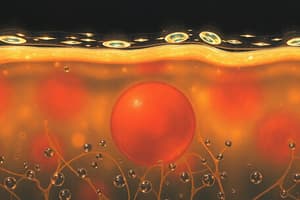Podcast
Questions and Answers
What drives the movement of water during osmosis?
What drives the movement of water during osmosis?
- Movement from areas of high water potential to low water potential. (correct)
- Active transport requiring cell energy.
- Movement from areas of high solute concentration to low solute concentration.
- Movement from areas of low water potential to high water potential.
A cell is placed in a solution where the concentration of solutes is lower than inside the cell. What is the correct term to describe this type of solution?
A cell is placed in a solution where the concentration of solutes is lower than inside the cell. What is the correct term to describe this type of solution?
- Isotonic
- Hypertonic
- Hypotonic (correct)
- Equilibrium
Which of the following best describes the nature of osmosis through a cell membrane?
Which of the following best describes the nature of osmosis through a cell membrane?
- A passive process where water moves through a channel protein.
- An active process that requires transport proteins to move water.
- Requires energy to move water through the membrane against the concentration gradient
- An energy-free process where water moves down its concentration gradient. (correct)
If a cell is placed in a hypertonic solution, what will be the net movement of water?
If a cell is placed in a hypertonic solution, what will be the net movement of water?
Which of the following scenarios will result in no net movement of water across a cell membrane by osmosis?
Which of the following scenarios will result in no net movement of water across a cell membrane by osmosis?
What happens to a plant cell when it is placed in a hypotonic solution?
What happens to a plant cell when it is placed in a hypotonic solution?
If a potato tuber cylinder increases in mass when placed in a sugar solution, what does this indicate about the solution?
If a potato tuber cylinder increases in mass when placed in a sugar solution, what does this indicate about the solution?
What is the primary role of turgor pressure in plant cells?
What is the primary role of turgor pressure in plant cells?
What will happen to an animal cell if it is placed in distilled water (a very dilute solution)?
What will happen to an animal cell if it is placed in distilled water (a very dilute solution)?
What term describes a solution that causes water to move out of a cell?
What term describes a solution that causes water to move out of a cell?
What is the correct term for when the cell membrane moves away from the cell wall in a plant cell due to water loss?
What is the correct term for when the cell membrane moves away from the cell wall in a plant cell due to water loss?
In a model with a partially permeable membrane bag containing sugar solution placed in external solutions, what does the level of water in the tube indicate?
In a model with a partially permeable membrane bag containing sugar solution placed in external solutions, what does the level of water in the tube indicate?
If a cell is placed in an isotonic solution, what is the expected net movement of water?
If a cell is placed in an isotonic solution, what is the expected net movement of water?
Flashcards
Osmosis
Osmosis
The movement of water molecules from a region of high water concentration to a region of low water concentration across a selectively permeable membrane.
Isotonic solution
Isotonic solution
A solution where the concentration of solutes is the same inside and outside the cell. There is no net movement of water.
Hypertonic solution
Hypertonic solution
A solution where the concentration of solutes is higher outside the cell than inside. Water moves out of the cell.
Hypotonic solution
Hypotonic solution
Signup and view all the flashcards
Selectively permeable membrane
Selectively permeable membrane
Signup and view all the flashcards
Turgor Pressure
Turgor Pressure
Signup and view all the flashcards
Plasmolysis
Plasmolysis
Signup and view all the flashcards
Osmosis Experiment
Osmosis Experiment
Signup and view all the flashcards
Study Notes
Osmosis (1.3.2)
- Osmosis is the movement of water across cell membranes from a less concentrated solution to a more concentrated solution through a partially permeable membrane.
- Water moves from an area of high water potential to an area of low water potential.
- This process is passive, meaning it does not require energy.
- A dilute solution has a high water potential and a high concentration of water.
- A concentrated solution has a low water potential and a low concentration of water.
Modeling Osmosis
- The cytoplasm of a cell contains salts and sugars.
- A cell placed in a dilute solution will have water move into the cell.
- This can be modeled using a partially permeable membrane bag containing sugar molecules with a glass tube.
- The bag can be placed in solutions of varying concentrations to observe water movement.
Types of Solutions
- Isotonic: The concentration of sugar in the external solution is the same as the internal concentration. No net movement of water.
- Hypertonic: The concentration of sugar in the external solution is higher than the internal concentration. Water moves out of the cell.
- Hypotonic: The concentration of sugar in the external solution is lower than the internal concentration. Water moves into the cell.
Osmosis in Animals
- If the external solution is more dilute (higher water potential), water moves into animal cells, causing them to burst.
- If the external solution is more concentrated (lower water potential), water moves out of the animal cells, causing them to shrivel.
Osmosis in Plants
- If the external solution is more dilute, water moves into plant cells, causing them to swell and maintain turgor pressure (essential for plant rigidity).
- If the external solution is less dilute, water moves out of plant cells, causing them to become soft, eventually leading to plasmolysis (cell membrane separation from the cell wall).
Experiment: Effect of Sugar Solutions on Plant Tissue
- Placing potato tubers in different sugar solutions affects their mass as water moves in or out.
- Measuring the mass before and after placement allows for determining whether the external solution or the potato had a higher concentration.
- Calculating the percentage change in mass and plotting it on a graph reveals the relationship between the concentration of the sugar solution and the mass change of the potato.
Studying That Suits You
Use AI to generate personalized quizzes and flashcards to suit your learning preferences.





